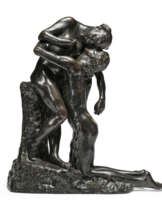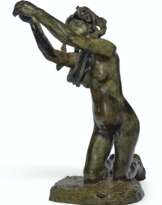ID 929408
Lot 30 | Camille Claudel (1864-1943)
Estimate value
€ 50 000 – 70 000
Çacountala
fusain et estompe sur papier
33.1 x 23.8 cm.
Exécuté vers 1888
charcoal and estompe on paper
13 x 9 3/8 in.
Executed circa 1888
Provenance
Victor Déséglise, Frapesle (avant 1916).
Paul et Magdeleine Lobbé Issoudun.
Collection particulière, Issoudun (par descendance en 1992).
Don de celle-ci au propriétaire actuel dans les années 2010.
Literature
P. Leroi, 'Salon de 1888' in L'Art, Revue Bi-mensuelle illustrée, Paris, 1888, vol. XLIV, p. 213 (illustré).
Camille Claudel, cat. exp. Paris, Musée Rodin et Poitiers, Musée Sainte-Croix, 1984, p. 132, no. 118 (illustré; titré 'L'Abandon').
A. de La Chapelle et R.-M. Paris, L'œuvre de Camille Claudel, Catalogue raisonné, Paris, 1990, p. 227, no. 80 (illustré).
A. Rivière, B. Gaudichon et D. Ghanassia, Camille Claudel, Catalogue raisonné, Paris, 1996, p. 168, no. 89 (illustré).
R.-M. Paris, Camille Claudel re-trouvée, Catalogue raisonné, Nouvelle édition revue et complétée, Paris, 2000, p. 485, no. 79 (illustré).
A. Le Normand-Romain, Rodin et le bronze, Catalogue des œuvres conservées au musée Rodin, Paris, 2007, vol. I, p. 330 (illustré, fig. 5).
P. Cressent et R.-M. Paris, Camille Claudel, Intégrale des œuvres, Paris, 2014, p. 221, no. 96 (illustré, p. 220).
P. Cressent et R.-M. Paris, Camille Claudel, Catalogue raisonné, Paris, 2019, p. 363, no. 53-5 (illustré).
Post lot text
« L'œuvre nouvelle la plus extraordinaire du salon est cette Çacountala, groupe chastement passionné dû à une jeune fille, Mlle Camille Claudel, que j'ai déjà en l'honneur de présenter à nos lecteurs et qui, merveilleusement douée, a de son art le sentiment le plus fier, qu'elle traduit virilement. Son faire est, en effet, de la plus surprenante sûreté et il est vraiment prodigieux qu'une femme aussi jeune ait pu concevoir et exécuter avec un tel succès un groupe de cette importance. C'est à peine si on y relève quelques imperfections de détails, qu'elle est du reste la première à reconnaître et qui disparaîtront à l'exécution définitive. Ces très légères défectuosités sont largement compensées par des délicatesses de création on ne peut plus remarquables, témoin cette main du jeune homme, cette main tremblante qui hésite encore à enlacer le corps de Cacountala, et l'exquis mouvement d'abandon inconscient de tout l'être de la jeune aimée. »
Paul Leroi cité in 'Salon de 1888' in L'Art, Revue Bi-mensuelle illustrée, Paris, 1888, vol. XLIV, p. 213 (illustré).
Exécuté vers 1888, ce dessin rare est une version au fusain d'un grand plâtre, Çacountala, que Camille Claudel expose pour la première fois au Salon des Artistes Français de 1888.
L'Abandon vibre de la tension magnétique que l'artiste fait naître entre ses protagonistes, deux amants déchirés par le destin et réunis après des années de séparation. Claudel parvient à traduire toute la complexité des émotions qui semblent peser sur ces retrouvailles grâce à une étude magistrale du nu et de ses potentiels expressifs. L'artiste n'a pas encore trente ans lorsqu'elle réalise ce groupe – l'un des plus ambitieux de sa jeunesse –, qui lui permet de révéler au public l'étendue de sa virtuosité technique et artistique.
Initié vers 1886, ce projet de sculpture s'inspire d'une légende indienne du cinquième siècle rendue célèbre par le poète sanskrit Kalidasa : l'histoire de la passion entre Douchmanta et sa bien-aimée Sakountala. Un jour, le roi Douchmanta rencontre une jeune femme en pleine forêt lors d'une partie de chasse. C'est le coup de foudre : ils filent bientôt le parfait amour et leur union est scellée par un mariage dans le respect des traditions. En gage de son affection et de son dévouement, Douchmanta offre à Sakountala une chevalière marquée du sceau de son royaume avant de quitter les lieux ; le devoir l'appelle, mais il promet de revenir la chercher. Or un sort s'abat sur le couple et vient effacer Sakountala de la mémoire de Douchmanta. Seule la vue de l'alliance pourrait lui rendre le souvenir de leurs amours, mais celle-ci a été perdue au fond d'une rivière, condamnant les amants à demeurer indéfiniment séparés. Sakountala se réfugie dans la forêt, où elle enfante le fils du roi. Il lui faut attendre de nombreuses années avant qu'un pêcheur retrouve l'anneau dans la panse d'un poisson et, reconnaissant les armoiries du royaume, qu'il le ramène à Douchmanta. Lorsqu'enfin tout lui revient en mémoire, le roi s'empresse de rejoindre son épouse délaissée. Claudel choisit de représenter le moment exalté des retrouvailles, l'instant fougueux où le roi Douchmanta s'agenouille pour enlacer Sakountala et implorer son pardon. Ici, la tendresse de l'étreinte l'emporte sur la charge érotique des corps nus ; la figure féminine incline notamment la tête dans une attitude qui trahit le poids de son émoi. Sur son visage semblent se mêler les sentiments de soulagement, de retenue, de crainte et d'espoir que lui inspirent le retour de l'être aimé après tant d'années d'attente. La sensualité de ce couple de Claudel est volontiers comparée à certains travaux de Rodin sur le thème des amants, comme L'Éternel Printemps (circa 1884), L’Éternelle Idole (circa 1890-1893) ou Le Baiser (1888-1898). Le caractère charnel, lascif de ces œuvres tranche toutefois nettement avec la délicatesse de sentiment que Claudel privilégie dans L'Abandon, où l'accent est mis sur les émotions contradictoires d'un personnage féminin décontenancé par le repentir de son prétendant. Le plâtre de Sakountala est achevé peu avant le Salon de 1888, où il est encensé et reçoit une mention honorable du jury. L'historien de l'art André Michel salue son « sentiment profond de tendresse chaste et passionnée, je ne sais quel frémissement et quelle ardeur contenue [...] » tandis que le critique Paul Leroi le considère comme « l’œuvre nouvelle la plus extraordinaire du Salon » (ibid).
Le présent dessin a d'abord appartenu à Victor Déséglise (1839-1916), bibliophile de renom proche de Camille Claudel. Il a été reproduit pour la première fois en 1888 entre les pages de L'Art, en guise d'illustration dudit article de Paul Leroi. Répertorié dans plusieurs ouvrages de référence de l’artiste, l’œuvre n’était connue que sous forme d’illustration de l’image de l’article de Leroi. Ainsi, ce dessin original de Claudel est une véritable redécouverte d’un bijou perdu, que Christie’s a l’honneur de présenter aujourd’hui.
"The most extraordinary new work of the show is this Sakountala, a chastely passionate set due to a young woman, Camille Claudel, whom I have already had the honour of introducing to our readers and who, marvellously gifted, has the proudest feeling for her art, which she translates with virile skill. Her work is, in fact, of the most astonishing reliability and it is truly extraordinary that such a young woman should have been able to conceive and execute a set of this importance with such success. There are hardly any imperfections in the details, which she is the first to recognise and which will disappear in the final execution. These very slight defects are largely compensated for by the most remarkable delicacy of creation, witness the hand of the young man, that trembling hand which still hesitates to embrace the body of Sakountala, and the exquisite movement of unconscious abandonment of the whole being of the young beloved."
Paul Leroi quoted in 'Salon de 1888' in L'Art, Bi-monthly illustrated magazine, Paris, 1888, vol. XLIV, p. 213 (illustrated).
Executed circa 1888, the present rare charcoal on paper has been drawn by Camille Claudel after the plaster version of the same subject, Sakountala, shown for the first time in 1888 at the Salon des Artistes Français in Paris.
Filled with an electric tension that radiates from the connection between the two principal figures, L’Abandon stands as one of the most renowned sculptures of Camille Claudel’s entire œuvre. Focusing on the dramatic moment of reunion between two lovers torn apart by fate, the composition is a masterful study in the expressive potential of the nude body, as Claudel masterfully conveys an impression of the wave of conflicting emotions which threaten to overwhelm the characters after years of separation. In her twenties when it was conceived, the work was among Claudel’s most ambitious early sculptural groups, and was intended as a public statement of her technical and artistic prowess.
L’Abandon had its origins in a sculptural group Claudel began around 1886, conceived under the title Sakuntala, a reference to the heroine of an Indian legend dramatised by the fifth-century Sanskrit poet Kalidasa, which tells the story of King Dushyanta and his beloved Sakuntala. The pair had met while the King was travelling through the forest one day, and instantly fell in love, marrying in a traditional ceremony. As a token of his love and a symbol of his devotion to her, Dushyanta gave Sakuntala a wedding ring bearing the royal seal of his kingdom, and promised to return for her as soon as he had completed his duties. To their great misfortune, a curse befell the couple, forcing Dushyanta to forget entirely about Sakuntala and his promise to her. Only their wedding ring could return his memories, but it had been lost in a river, meaning the lovers were destined to remain separated forever more. Sakuntala fled to the forest, where she bore the king a son. Many years passed, until one day a fisherman discovered the ring in the belly of a fish he had caught and, recognising the insignia, returned it to King Dushyanta. The sight of the ring immediately caused Dushyanta’s memories to come flooding back to him, and he rushed to find Sakuntala again.
Claudel chose to portray the moment of their passionate reunion, as King Dushyanta falls to his knees before Sakuntala begging forgiveness, embracing her as she sinks towards him under the force of her emotions. The eroticism of the two naked lovers is tempered by the tenderness of the scene, and in particular the expression on Sakuntala’s face, a mixture of relief, reservation, fear and hope, as her great love is finally returned to her after years of waiting.
The sensuous connection between the two lovers is often compared to Rodin’s works of a similar theme, in particular L'Éternel printemps (circa 1884), L’Éternelle Idole (circa 1890-1893) and Le baiser (1888-1898). However, the extreme lust of Rodin’s works contrasts sharply against the emotional depth evident in Claudel’s sculpture, which delves into the conflicting emotions felt by its title character as her lover begs her forgiveness for his absence.
The plaster of Sakuntala was completed in time for the 1888 Salon, where it earned Camille widespread praise and an honourable mention from the awarding committee. André Michel praised its ‘profound feeling of tenderness both chaste and passionate, an impression of quivering, of restrained ardour…,’ while Paul Leroi proclaimed it ‘the most extraordinary new work in the Salon (quoted in ibid).
The present drawing was first in the collection of Victor Déséglise (1839-1916), famous bibliophile close to Camille Claudel.
It has been published for the first time in 1888 in L’Art to illustrate the article written by Paul Leroi, to comment the Salon des Artistes Français. Illustrated in several reference books on the artist, this drawing was only known from the reproduction of the image taken from Leroi’s article. Therefore, this original drawing by Claudel is a true discovery of a lost treasure, which Christie’s is proud to present today.
| Artist: | Camille Claudel (1864 - 1943) |
|---|---|
| Applied technique: | Charcoal |
| Medium: | Wood |
| Artist: | Camille Claudel (1864 - 1943) |
|---|---|
| Applied technique: | Charcoal |
| Medium: | Wood |
| Address of auction |
CHRISTIE'S 9 Avenue Matignon 75008 Paris France | ||||||||||||||
|---|---|---|---|---|---|---|---|---|---|---|---|---|---|---|---|
| Preview |
| ||||||||||||||
| Phone | +33 (0)1 40 76 85 85 | ||||||||||||||
| Fax | +33 (0)1 40 76 85 86 | ||||||||||||||
| Conditions of purchase | Conditions of purchase | ||||||||||||||
| Shipping |
Postal service Courier service pickup by yourself | ||||||||||||||
| Payment methods |
Wire Transfer | ||||||||||||||
| Business hours | Business hours
|











